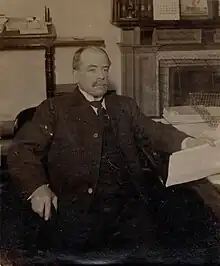
Stanleigh Pohly Friedman (1884 – 1960) was an American early 20th century composer of popular music. He is best known for writing the melody of the Yale fight song, Down the Field, also known as "March, March on Down the Field".
Background and education
Friedman was born on August 12, 1884, in Albany, New York. He was a student in the Yale Law School, class of 1905, and Harvard, class of 1908. His interest in writing music was evident throughout his time at Yale. An interest he shared with his roommate, C.W. O'Connor. In addition to his law studies, he was involved with the Yale University Music School, led by professor and composer Horatio Parker. He wrote and published one of his first college songs in 1903, titled 'Neath the Elms',[1] most likely inspired by the elm trees of the old Yale campus and surrounding New Haven, Connecticut. Friedman and O'Connor were the originators of one of Yale University's most celebrated fight songs, 'Down the Field', drafted in June 1904.[2]
March, March on Down the Field
Friedman penned the melody to 'Down the Field' while attending a lecture on economics, and it was first heard being sung publicly at a Yale-Princeton football match in the fall of 1904.[3] The march song's success was felt throughout the United States,[4] equaling the success of the 1901 Boola! song by Allan M. Hirsh. The march was published in New Haven, under the direction of publisher Chas. Loomis,[5] who would later assign the rights to Leo. Feist in 1911. From this acquisition, 'Down the Field' march resurged in popularity in 1911, through sheet music sales as well as phonograph records. It was recorded by Arthur Pryor's Band, the Knickerbocker Quartet,[6] the Shannon Four (Shannon Quartet) among many other vocal groups and concert bands in the 1910s. 'Down the Field' was also recorded by Rudy Vallee,[7] Bunny Berigan and Kay Kyser.
By 1905, Stanleigh was well acquainted with the musical activities at Yale, and was elected President of the university orchestra.[8] He directed the orchestra in a 1905 school production of "The Magistrate".[9] In 1906, Friedman would write a follow-up composition to 'Down the Field' titled 'Whoop It Up',[10][11] with words by Henry G. Dodge. This fight song was not as popular as his primary work. In 1920, he would publish 'Glory For Yale',[12] with words by Julian Arnold. He recorded this march among others that same year for Okeh records as director with the New England Society Orchestra.
Thirty years after writing 'Down the Field', in 1935, he wrote and dedicated a limited campus store print of 'Sons of Eli' to his former roommate and co-writer, C.W. O'Connor.
Later career
Friedman would practice law in New York by 1912 in the law firm of Friedman & Bareford I, but remained active in the entertainment industry. He was a founder of the film studios Octagon Films Inc.[13] and Grossman Pictures Inc.[14], led by Harry Grossman. He went on to becoming a director and vice president of Warner Bros.[2][4] in 1931. He was active at Warner Bros. into the 1950s.[15]
Friedman also served as President of the Schola Cantorum of New York and the Ballet Associates in America.[4] Two arrangements of J.S. Bach's "Gavotte en Rondeau" and "Bist Du Bei Mir" by Friedman were performed by the New York Philharmonic.[16] Friedman wrote religious music as well, including the works "God is My Trust"[17] and "All Ye That Cleave Unto the Lord", a cantata.
Legacy
Friedman's name can be found inscribed on the walls of Welch Hall at Yale for his contribution to the school's fight songs. 'Down the Field' is still performed by the Yale Bands today.
References
- ↑ "New Yale Song". The Daily Morning Journal and Courier. January 18, 1904.
- 1 2 "Lingering Melodies". Sports Illustrated. September 20, 1976.
- ↑ "Original Draft of "Down the Field" Now in Sterling Library Collection". Yale Daily News. July 18, 1942.
- 1 2 3 Spaeth, Sigmund (1948). A History of Popular Music in America. p. 379.
- ↑ ""Down the Field" : March and Two Step". Archives at Yale. Gilmore Music Library Repository.
- ↑ "Songs of Yale". UCSB Cylinder Audio Archive. UC Santa Barbara Library. 16 November 2005.
- ↑ Winstead, J. Lloyd (2013). When Colleges Sang: The Story of Singing in American College Life. University of Alabama Press. p. 183. ISBN 9780817317904.
- ↑ Oren, Dan A. (1985). Joining the Club: A History of Jews and Yale. New Haven: Yale University Press. p. 34.
- ↑ "The Yale Play". The Daily Morning Journal and Courier. March 30, 1905.
- ↑ Rehrig, William H. (1991). The Heritage Encyclopedia of Band Music: Composers and Their Music Volume 3. Westerville, Ohio: Integrity Press. p. 290.
- ↑ "New Yale Songs". The Daily Morning Journal and Courier. November 24, 1906.
- ↑ Studwell, William; Shueneman, Bruce (2011). College Fight Songs II: A Supplementary Anthology. New York: Routledge. ISBN 9781136388316.
- ↑ "Exhibitors". The Billboard. No. 37. September 14, 1918.
- ↑ "Incorporations". New-York Tribune. September 10, 1919.
- ↑ "Complete Warner Sale". Canadian Film Weekly. 21 (30): 1. July 25, 1956.
- ↑ "Obituaries". Variety. 220: 79. October 5, 1960.
- ↑ "Song Collections". Music Educators Journal. 31 (6): 71. May–June 1945.